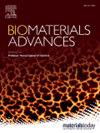生物矿化硫化铜纳米颗粒在体内和体外非酒精性脂肪肝模型中加剧的肝毒性
IF 5.5
2区 医学
Q2 MATERIALS SCIENCE, BIOMATERIALS
Materials Science & Engineering C-Materials for Biological Applications
Pub Date : 2024-11-18
DOI:10.1016/j.bioadv.2024.214117
引用次数: 0
摘要
通过生物矿化合成的硫化铜纳米粒子(NPs)作为光热剂具有巨大的商业潜力,但对这些NPs的安全性评估,尤其是对非酒精性脂肪肝(NAFL)患者的安全性评估仍然不足。为了探索硫化铜 NPs 在非酒精性脂肪肝条件下的不同肝毒性,我们合成了大尺寸(LNPs,15.1 nm)和小尺寸(SNPs,3.5 nm)BSA@Cu2-xS NPs。通过每天重复给药 BSA@Cu2-xS NPs,成功建立了以高脂饮食(HFD)喂养的 NAFL 大鼠模型,并进行了为期 14 天的亚急性毒性研究。血清生化和组织病理学检查结果表明,与正常饮食喂养的大鼠相比,两种尺寸的硫化铜 NPs 对 NAFL 大鼠肝脏的损伤更为明显。转录组测序分析表明,LNPs 激活了非酒精性脂肪肝大鼠肝脏中的炎症和 DNA 损伤修复途径,而 SNPs 则显示出极少的炎症。我们在内部细胞球形培养蜂巢芯片中开发的非酒精性脂肪肝三维球形模型表明,LNPs(而非 SNPs)会通过 Kupffer 细胞引发炎症因子的明显释放和活性氧的增加。这些结果突出表明,非酒精性脂肪肝会加剧 BSA@Cu2-xS NPs 的肝毒性,与 LNPs 相比,SNPs 成为更安全的光热制剂,这表明 SNPs 具有更优越的临床应用潜力。本文章由计算机程序翻译,如有差异,请以英文原文为准。
Exacerbated hepatotoxicity in in vivo and in vitro non-alcoholic fatty liver models by biomineralized copper sulfide nanoparticles
Copper sulfide nanoparticles (NPs) synthesized through biomineralization have significant commercial potential as photothermal agents, while the safety evaluation of these NPs, especially for patients with non-alcoholic fatty liver (NAFL), remains insufficient. To explore the differential hepatotoxicity of copper sulfide NPs in NAFL conditions, we synthesized large-sized (LNPs, 15.1 nm) and small-sized (SNPs, 3.5 nm) BSA@Cu2-xS NPs. A NAFL rat model fed with high fat diet (HFD) was successfully established for a 14-day subacute toxicity study by daily repeated administration of BSA@Cu2-xS NPs. Our findings from serum biochemistry and histopathological examinations revealed that copper sulfide at both sizes NPs induced more pronounced liver damage in NAFL rats than rats fed with normal diet. Transcriptome sequencing analysis showed that LNPs activated inflammation and DNA damage repair pathways in the livers of NAFL rats, while SNPs displayed minimal inflammation. A three-dimensional spheroid model of NAFL developed in our in-house cell spheroid culture honeycomb chips demonstrated that LNPs, but not SNPs, triggered a distinct release of inflammatory factors and increased reactive oxygen species through Kupffer cells. These results highlight that NAFL condition exacerbated the hepatotoxicity of BSA@Cu2-xS NPs, with SNPs emerging as safer photothermal agents compared to LNPs, suggesting superior potential for clinical applications.
求助全文
通过发布文献求助,成功后即可免费获取论文全文。
去求助
来源期刊
CiteScore
17.80
自引率
0.00%
发文量
501
审稿时长
27 days
期刊介绍:
Biomaterials Advances, previously known as Materials Science and Engineering: C-Materials for Biological Applications (P-ISSN: 0928-4931, E-ISSN: 1873-0191). Includes topics at the interface of the biomedical sciences and materials engineering. These topics include:
• Bioinspired and biomimetic materials for medical applications
• Materials of biological origin for medical applications
• Materials for "active" medical applications
• Self-assembling and self-healing materials for medical applications
• "Smart" (i.e., stimulus-response) materials for medical applications
• Ceramic, metallic, polymeric, and composite materials for medical applications
• Materials for in vivo sensing
• Materials for in vivo imaging
• Materials for delivery of pharmacologic agents and vaccines
• Novel approaches for characterizing and modeling materials for medical applications
Manuscripts on biological topics without a materials science component, or manuscripts on materials science without biological applications, will not be considered for publication in Materials Science and Engineering C. New submissions are first assessed for language, scope and originality (plagiarism check) and can be desk rejected before review if they need English language improvements, are out of scope or present excessive duplication with published sources.
Biomaterials Advances sits within Elsevier''s biomaterials science portfolio alongside Biomaterials, Materials Today Bio and Biomaterials and Biosystems. As part of the broader Materials Today family, Biomaterials Advances offers authors rigorous peer review, rapid decisions, and high visibility. We look forward to receiving your submissions!

 求助内容:
求助内容: 应助结果提醒方式:
应助结果提醒方式:


